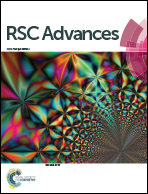Synthesis, characterization and nonlinear optical studies of novel blue-light emitting room temperature truxene discotic liquid crystals
Abstract
A new series of discotic liquid crystals based on a truxene core has been synthesized to study the structure–property relationship in view of the self-assembling property and their linear and nonlinear optical properties. All these branched alkyl chain truxene derivatives show a mesogenic property in a columnar hexagonal fashion at room temperature which is studied by a combination of different techniques. The newly synthesized truxene discotic 7a possesses a clearing temperature of 117 °C, one of the lowest clearing temperatures known in truxene discotic liquid crystals. We have discovered that the introduction of branching near to the core even in a small alkyl chain drastically reduces the isotropic temperature. Due to their C3 symmetry and their large first hyperpolarizability, these truxene derivatives show long-lived emissions in the solution state at room temperature. We also report large effective three-photon absorption in these materials under nanosecond laser pulse excitation at 532 nm, which makes them suitable candidates for optical limiting applications.


 Please wait while we load your content...
Please wait while we load your content...